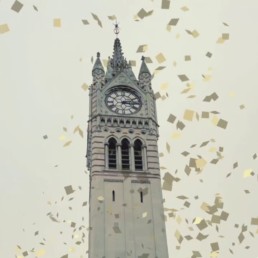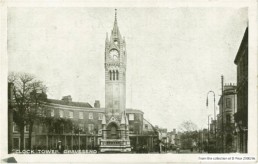Gravesend Clock Tower
Take a selfie in front of the Gravesend Clock Tower beneath the golden confetti, and ring the bell to celebrate Queen Victoria’s Golden Jubilee!
Choose the Instagram or Facebook button below to open the AR experience.
Use your front facing camera to capture your Jubilee celebrations. Tap to ring the clock tower bell and hold your finger down to release the celebratory confetti.
This experience will open your camera feed. Turn your sound on to enjoy the full experience.
History
The year was 1887, and up and down the country Victorians were thinking about ways in which they could celebrate the Golden Jubilee of their Queen. In Gravesend, a committee was formed to consider a variety of proposals ranging from a public landing stage close to Town Pier to the endowment of the hospital. The committee’s vote was unanimous in favour of a clock tower.
The sum of £679 14 shilling (£679.70) was eventually raised and architects were invited to submit designs under pseudonyms so that there could be no bias in the judging. The winning architect used the name ‘Experience’ and was Mr John Johnson. The building of the tower was put out to tender and Mr W H Archer’s costing of £675 to build a Portland Stone tower was accepted. The end of Harmer Street was the site chosen for the clock tower. The street itself is lined with impressive four-storey terrace buildings that are part of the ‘new’ Gravesend started in the 1840s. The architect Amon Henry Wilds (who also designed the Town Hall) planned a grand route leading from the riverside at the Royal Terrace Pier right up to Windmill Hill. At the riverside end, there were pleasure gardens designed by J C Loudon, a well-known landscape designer of the day. The clock tower was constructed on the centre point of the route at Berkley Crescent. The foundation stone was laid on 6 September 1887 and was the highpoint of the Queen’s Jubilee celebrations with over 6,000 people attending the ceremony.
Under the foundation stone in a sealed bottle are copies of local papers and coins minted specially for the Jubilee. The money to pay for the clock itself still had to be raised and it was the 5 June 1889 before the Mayor started the clock for the first time. The dial was lit by gaslight which turned off automatically at daylight. Contemporary sources suggest Smith & Son of the Midland Clock Company made the clock and the bells were cast by Warner & Co, Cripplegate, London. The total cost for the clock and tower was £1,097. It stands over 50ft (18.2 m) high and each clock face is 5 ft 6in (1.6 m) in diameter.


